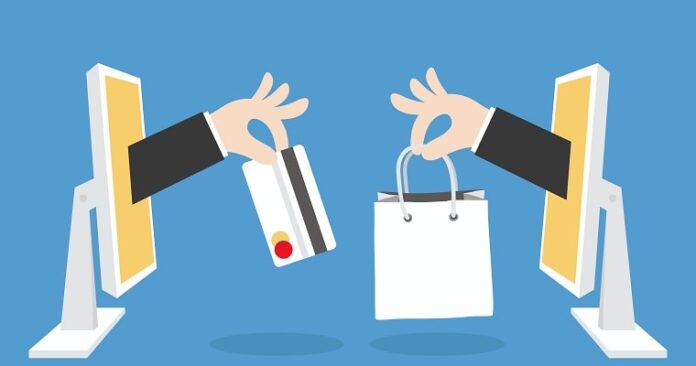By Hannah McNamee
There was a time when analysts who predicted that electronic commerce (commonly known as ecommerce) might overtake traditional retail could easily be dismissed as dramatic.
Today, with over 2.14 billion people expected to buy goods and services using online shopping, traditional retailers are starting to take such views more seriously, and they need to.
Ecommerce businesses were already doing well before the COVID-19 pandemic. However, the restrictions imposed by many governments attempting to curtail the spread of the virus left many firms and individuals with no choice but to go digital.
In this article, we define the idea of ecommerce. But why is this definition crucial for people in the ecommerce business and online marketplaces? To successfully run a business, whether it’s an online store or a physical store, it’s vital to know the industry’s intricacies.
To help you understand the ecommerce business model, we will focus on the history of ecommerce, types of ecommerce, how the online business works, and how it changes the overall face of business. We also look at popular ecommerce platforms, the features of a successful ecommerce website, and the advantages and disadvantages of ecommerce. Finally, we look at future ecommerce trends.
Defining Ecommerce
Ecommerce is a business model that involves the selling and buying of goods and services over the internet. This is why it is sometimes called internet shopping. You could think about ecommerce as a digital substitute for brick-and-mortar stores.
When using ecommerce, instead of walking or driving to the business selling the goods and services you need, you visit the business’ ecommerce website, select the goods and services you want, and pay for them. Once payment is received, the merchant or seller will ship the goods to your preferred address or provide the service you purchased.
Ecommerce can be conducted by anyone who has a device such as a smartphone, tablet, computer, and internet connection. The buyer will also need to have a payment method or credit card accepted by the seller of the physical or digital products.
Types of Ecommerce

If you want to establish an ecommerce business, you will need to start by determining the ecommerce business model suitable for your needs. There are four common ecommerce business models you can choose from:
B2C: The business-to-consumer model is possibly the type of ecommerce that most of us are used to. It involves businesses selling to the general public. Walmart and Amazon are some of the best examples of ecommerce businesses using the B2C ecommerce model.
B2B: The business-to-business ecommerce model involves the sale of goods and services online between businesses. A perfect example of a company that uses this model is Alibaba. Because businesses that purchase goods and services from other businesses would later sell them for a profit, prices in B2B ecommerce tend to be low so that buyers can make a profit when they sell the goods later.
C2B: In the consumer-to-business model, the consumer sells products or services to businesses. An example of how ecommerce happens in this sector is when a freelancer sells services like copywriting, web design, or photography to a business.
CTC: When a consumer sells goods and services to other consumers, they use the consumer-to-consumer type of ecommerce.This kind of ecommerce involves the selling of goods on websites like Craigslist or eBay.
Alibaba is a popular B2B ecommerce retailer that dominates the Chinese market.
The History of Ecommerce
The idea that would later turn into ecommerce can be traced back to the 1970s, before many of us even knew what the word internet or search engine means. According to the Canadian multinational ecommerce company that provides a platform for online stores, Shopify, students at Stanford University used an early packet switching network “to quietly arrange the sale, and purchase, of the first product ever sold through telecommunications—marijuana.”
While the students at Stanford and MIT were arranging for the sale of marijuana using a telecommunications network, the man credited for inventing what we know today as ecommerce was working on a more serious idea. This man is the English entrepreneur and inventor Michael Aldrich.
According to HistoryOfInformation.com, Aldrich’s “system connected a modified domestic TV to a real-time transaction processing computer via a domestic telephone line.” The system was known as Videotex. Using the system, retailer computers would process real-time transactions.
With the Videotex, the BBC reports that Aldrich “had built a real-time, multi-user transaction processing computer.”
The BBC also reports that “Grandmother Jane Snowball, 72, sat down in an armchair in her Gateshead home in May 1984, picked up a television remote control and used it to order the groceries from her local supermarket.” With this act, using Videotex technology, Mrs. Snowball would become the first online shopper.
Aldrich’s idea didn’t become popular until the widespread use of the internet. Shopify.com follows the history of ecommerce as we know it today back to 1994 when Pizza Hut conducted the internet’s first ecommerce sale: a large pizza.
While the 1994 sale of the large pizza by Pizza Hut is widely recognized as the first ecommerce transaction, Shopify.com reports that the real pioneer of ecommerce was a customer who bought a Sting CD from the US retail platform NetMarket. The transaction happened on August 11, 1994.
The Ecommerce Timeline
BigCommerce.com, a SaaS ecommerce platform, presents an ecommerce development timeline. Here are some of the big ecommerce milestones that have seen online retail get to where it is today:
1969: The establishment of CompuServe enabled the connectivity that prompted the email marketing that would later spur ecommerce.
1979: Aldrich invents electronic shopping.
1982: The Boston Computer Exchange launches the first online marketplace.
1994: Netscape Navigator is launched and becomes the primary web browser on the Windows platform, enabling ecommerce marketplaces to conduct online sales.
1995: Amazon is launched by Jeff Bezos, primarily selling books.
1998: PayPal is launched, becoming one of the leading payment gateways for companies and individuals buying and selling products online.
1999: Alibaba, one of today’s biggest online retailers, launches.
2004: Shopify is established.
2005: Etsy launches.
2009: The bootstrapped ecommerce storefront platform BigCommerce launches.
2020: Covid-19 forces many business owners and consumers to consider the online marketplace as a viable option, with retailers like Walmart growing online sales by 79% in the year of COVID-19.
How Ecommerce Works
Today, the internet facilitates ecommerce. Online stores can sell goods from websites that they manage on their own, like Amazon and Walmart, or use ecommerce platforms like BigCommerce or Shopify. Individuals and freelancers can also use ecommerce websites such as Etsy or eBay to sell their goods.
Web-based online stores make it possible for consumers to browse through and find products or services they need. When a customer finds the goods or services they want they place the goods or services in a digital shopping cart within the company’s website.
When the customer is ready to buy the products or services they have placed in their shopping cart, they proceed to the transaction’s checkout phase. This phase is managed by an arrangement of computers that accept the order, process the payment, communicate with inventory management, and ship the goods to the customer or provide a service.
A typical ecommerce buying process. The goal is to make this as seamless and secure as possible.
Types of Ecommerce Website

Without a website where the ecommerce business can display its products and connect with consumers, ecommerce would not be possible. If you want to run an ecommerce store, you will need to start by deciding on the type of website you will use.
Physical goods: Owners of brick-and-mortar stores are starting to recognize the opportunities presented by ecommerce. Consequently, they are optimizing their websites to facilitate online sales. The main advantage of an ecommerce website that sells physical goods lies in the fact that it allows a business to grow sales without investing in more stores.
Digital products: The rise of the internet and other communication technologies has also spurred a market for digital products like games, software, and website templates, which do not require a physical store. If your business is in this area, you will use a digital products ecommerce website.
Services: Providers of services like copywriting, graphic design, editing, or consulting have experienced a boom in the last few years. These services can be facilitated through a services-based ecommerce website.
Dropshipping: Even though dropshipping shares many similarities with the selling of physical goods, it is different in that you do not need to hold inventory. A business of this kind acts as the mediator between suppliers and customers. Customers buy the products from the dropshipper’s site. The order is fulfilled by the supplier, who gets paid by the dropshipper.
Features Of An Ecommerce Website
For an ecommerce website to facilitate business, it needs to have certain features. Here are some of the primary features of a successful ecommerce website:
Easy to use: If visitors to your ecommerce website feel that finding whatever they are looking for is difficult they will leave without buying and are unlikely to come back. This will require you to find a website template or website designer that will make your ecommerce site easy to navigate.
User-focused: A successful ecommerce website is run by a business that knows its target consumers and improves the user experience. Knowing the needs and preferences of shoppers that will buy from you ensures that you use themes, tone of voice, and aesthetics to appeal to that group.
Mobile optimized: Many people use ecommerce because they enjoy the convenience of buying goods from wherever they are. This is the reason a mobile-optimized website is a must for an ecommerce business. Search engines also factor in mobile readiness in their ranking algorithms.
Security: An ecommerce website may have all the great features, but if shoppers do not feel secure, the business is unlikely to succeed. Without security, both the business and shoppers are at risk of identity theft and fraud, which could cause irreparable damage to a brand.
SEO: If an ecommerce business does not appear on search engines, very few people will know it exists. However, appearing on search engines in a sea of websites on the internet requires search engine optimization, which will ensure that an ecommerce website appears on the top pages of search engines.
As technology advances, the capabilities of ecommerce services will improve and contribute to the overall customer experience. For example, eyewear manufacturers Warby Parker made an app that enables customers to try on their frames virtually before deciding to purchase from their online store.
Warby Parker enables customers to try on frames virtually.
Advantages and Disadvantages of Ecommerce
An ecommerce business presents several advantages. It is generally a cheap startup business idea that a single individual can run.
A website is available 24/7, so customers can view and purchase your products at their convenience, and you are not restricted by location. The benefits of ecommerce became clear when businesses were forced to shut down because of many governments’ restrictions to stop the spread of Covid-19.
However, like any other business model, ecommerce has its disadvantages. Starting an ecommerce business is not difficult, which makes this area a cutthroat environment. Security threats, including identity theft and fraud, are rampant on the internet, which means that ecommerce businesses have to manage complicated online security.
Cart abandonment and returned goods are common challenges in ecommerce as people may discover that they don’t like the actual product they purchased when it arrives. This can reduce profits and increase costs.
Ecommerce Platforms
An ecommerce website facilitates online transactions. It provides a business with the opportunity to showcase their goods and services and connect with consumers or other businesses.
Big businesses like Amazon, Walmart, or Alibaba have the resources to build their own websites and maintain them. However, many small businesses do not have the same resources and often turn to ecommerce platforms.
An ecommerce platform provides the software that makes it possible for providers of goods and services online to manage their businesses. This kind of software can include tools for building and managing an ecommerce website, marketing, customer service, accounting, and inventory.
Some of the best ecommerce platforms include Shopify, Magento, Wix, MeGaDev, and BigCommerce. There are also several open-source ecommerce platforms like Drupal Commerce, Open Freeway, Magento Open Source, Spree Commerce, and Solidus.
BigCommerce is an easy to use platform for launching an online store.
Ecommerce platforms come with many advantages. They ensure that ecommerce businesses focus on their core business: selling goods and services to customers. The software takes away the headache linked to managing various processes such as accepting payments, ensuring adequate stock, dealing with a website’s technical issues, and managing customer feedback.
How Ecommerce Has Changed Business
The rapid growth of ecommerce in the last decade has impacted both small businesses and big retailers. This growth has benefited from the introduction of technologies and mobile devices that make ecommerce possible. But how does ecommerce affect the retail sales and services landscape?
Market Share Is Shifting
An April 2019 article published by CNBC.com cites the Commerce Department, which reported that “The total market share of ‘non-store,’ or online US retail sales was higher than general merchandise sales for the first time in history.”
The quote from CNBC.com above shows that ecommerce is rapidly eating into the market that used to be exclusively enjoyed by brick-and-mortar stores.
Small Businesses Compete With Large Retailers
To a certain degree, the internet has dismantled the frontiers that may have made it a challenge for small businesses to access international markets. Today, anyone with an ecommerce website and some search engine optimization (SEO) skills can successfully run an ecommerce store that competes in the same space with large retailers.
The rise of dropshipping has enabled small business owners to create a customer base without the need for inventory management, providing buyers with a broader choice. This kind of competition and choice is likely to result in a better customer experience as those who sell products try to outdo each other to please customers.
The Changing Retail Jobs Landscape
According to the New York Times, “Ecommerce jobs are growing fast …” In a 2017 article, the same newspaper reports that “Employment attributed to electronic shopping firms has doubled in the last five years, outpacing other types of retail.”
However, the New York Times reports that employment in the ecommerce sector is still a tiny fraction compared to warehouse clubs, grocery stores, and departmental stores. This is because selling goods and services online is less labor-intensive when compared to selling in traditional brick-and-mortar stores.
Changing Shopping Habits
Ecommerce is changing the way customers shop. BigCommerce.com reports that 51% of Millennials in America now prefer to shop online rather than in-store.
The changing customer habits are driven mainly by social media’s proliferation, making it easier for consumers to share information, recommendations, and reviews about pricing, the quality of goods, and overall service.
Businesses are cooperating with influencers on social media to create hype when introducing new products into the market.
The Future of Ecommerce
As technologies become more sophisticated, ecommerce is also likely to become more popular. For example, augmented reality is expected to help many online shoppers to get as close an idea of the goods or services they are purchasing as possible.
Many consumers who may have had doubts about online shopping were forced to try it due to Covid-19 restrictions. Some will likely start to enjoy its convenience and continue shopping online even after the pandemic.
Statistics provided by Statista predict that ecommerce revenues will grow at an annual rate of 4.68% between 2021 and 2025, “resulting in a projected market volume of US$563,388m by 2025.” The future certainly looks bright for e-commerce businesses.
About Author
 The author is a digital marketer at Black + White Zebra Inc, an indie media publishing company based in Vancouver, BC. She is passionate about digital trends surrounding marketing and ecommerce.
The author is a digital marketer at Black + White Zebra Inc, an indie media publishing company based in Vancouver, BC. She is passionate about digital trends surrounding marketing and ecommerce.
(Published in partnership with TheEcommmanager.com. Originally published here.)












